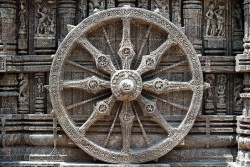Difference between revisions of "The Origins of Zen"
m (1 revision: fix) |
|||
| Line 1: | Line 1: | ||
[[File:C629d8.jpg|thumb|250px|]] | [[File:C629d8.jpg|thumb|250px|]] | ||
| − | [[Zen]] is a school of [[Buddhism]] which emphasises the practice of meditation as the key ingredient to awakening ones inner nature, compassion and wisdom. The practice of meditation (Zen in Japanese) as a means of attaining enlightenment was introduced, as we have seen, by the Buddha himself. Zen approached Buddhism in the most direct, simple and practical way. It grasped that enlightenment was the most fundamental aspect of Buddhism and thus did away with sacred scriptures, rituals and objects of worship, all of which had become a major aspect of Mahayana Buddhism in India. | + | [[Zen]] is a school of [[Buddhism]] which emphasises the practice of [[meditation]] as the key ingredient to [[awakening]] ones inner nature, [[compassion]] and [[wisdom]]. The practice of [[meditation]] ([[Zen]] in [[Japanese]]) as a means of [[attaining]] [[enlightenment]] was introduced, as we have seen, by the [[Buddha]] himself. [[Zen]] approached [[Buddhism]] in the most direct, simple and practical way. It grasped that [[enlightenment]] was the most fundamental aspect of [[Buddhism]] and thus did away with [[sacred]] [[scriptures]], [[rituals]] and [[objects]] of {{Wiki|worship}}, all of which had become a major aspect of [[Mahayana Buddhism]] in [[India]]. |
| − | This more direct approach was introduced into China in the sixth century by the travelling Indian monk [[Bodhidarma]]. It was introduced into Japan a century later. In this new method (or no method) approach spiritual truth was to be transmitted not by words but by spiritual enlightenment. To this end Zen masters used (as well as meditation) question and answer riddles known as koans to trigger rapid enlightenment in their students by shocking them out of their conventional ways of logical thinking. One well known koan is to contemplate the sound of one hand clapping. In addition they also used Zen poetry, painting and calligraphy as vehicles to enlightenment or as fingers pointing to the moon. | + | This more direct approach was introduced into [[China]] in the sixth century by the travelling [[Indian]] [[monk]] [[Bodhidarma]]. It was introduced into [[Japan]] a century later. In this new method (or no method) approach [[spiritual]] [[truth]] was to be transmitted not by words but by [[spiritual]] [[enlightenment]]. To this end [[Zen]] [[masters]] used (as well as [[meditation]]) question and answer riddles known as [[koans]] to trigger rapid [[enlightenment]] in their students by shocking them out of their {{Wiki|conventional}} ways of [[logical]] [[thinking]]. One well known [[koan]] is to [[contemplate]] the [[sound]] of one hand clapping. In addition they also used [[Zen]] [[poetry]], painting and {{Wiki|calligraphy}} as vehicles to [[enlightenment]] or as fingers pointing to the [[moon]]. |
{{R}} | {{R}} | ||
[http://www.ngv.vic.gov.au/artofzen/ed_zen_history.html www.ngv.vic.gov.au] | [http://www.ngv.vic.gov.au/artofzen/ed_zen_history.html www.ngv.vic.gov.au] | ||
Revision as of 12:27, 17 September 2013
Zen is a school of Buddhism which emphasises the practice of meditation as the key ingredient to awakening ones inner nature, compassion and wisdom. The practice of meditation (Zen in Japanese) as a means of attaining enlightenment was introduced, as we have seen, by the Buddha himself. Zen approached Buddhism in the most direct, simple and practical way. It grasped that enlightenment was the most fundamental aspect of Buddhism and thus did away with sacred scriptures, rituals and objects of worship, all of which had become a major aspect of Mahayana Buddhism in India.
This more direct approach was introduced into China in the sixth century by the travelling Indian monk Bodhidarma. It was introduced into Japan a century later. In this new method (or no method) approach spiritual truth was to be transmitted not by words but by spiritual enlightenment. To this end Zen masters used (as well as meditation) question and answer riddles known as koans to trigger rapid enlightenment in their students by shocking them out of their conventional ways of logical thinking. One well known koan is to contemplate the sound of one hand clapping. In addition they also used Zen poetry, painting and calligraphy as vehicles to enlightenment or as fingers pointing to the moon.
